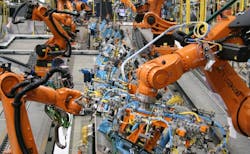Driving the Surge in Automotive Automation
Kicking off the Automotive Manufacturing Summit at the Manufacturing in America Symposium in Detroit (March 20, 2013), Raj Batra, president of industry automation for Siemens Industry Inc., outlined three key issues for the manufacturing sector in the U.S. Though broadly applicable to the manufacturing industry as a whole, these issues are playing out, often visibly, in the automotive industry in particular. The issues outlined by Batra are:
• Offshore manufacturing of low-tech commodities won’t change, but high-value, high technology products can’t be built just anywhere. They have to be built where innovation occurs.
• The idea that energy costs will always rise in U.S. is no longer true. Shale gas plays will cause liquid natural gas prices to be 50-70 percent cheaper. This, in particular, is a big driver of re-shoring because of its positive production cost effects.
• Manufacturing is no longer about brawn over brains. Manufacturing has become knowledge work as products and production processes become intensely complex.
Underscoring many of the points illustrated by Batra, Mike Bastian, controls manager for powertrain manufacturing at Ford Motor Co., talked about the issues he’s dealing with today.
With regard to the prevalence of enterprise level technology on the factory floor, Bastian said, “The line of demarcation between IT and controls is getting grayer.” He made it clear that he thinks a good line of separation between the two needs to exist; but when you have an issue with the Ethernet network on the plant floor, he asks: “Who do you call?”
Bastian characterized Ford as being a “cautious adopter of new technology, but wants to be a fast second adopter. We can't just unleash new technology on the plant floor and hope that it works,” he said.
Despite Ford’s overall caution when it comes to cutting edge technology adoption, Bastian noted four key areas of high-end technology application that the company is focusing on now:
• Systems integration in terms of production software and how equipment communicates;
• Part marking innovations that are enabling Ford to eliminate RFID use;
• Increasing use of robotics; and
• Use of wireless and high-availability networks.
On the heels of the Automotive Manufacturing Summit, ARC Advisory Group released a study— “Automation Expenditures in Automotive Industry”—indicating that automation expenditures for manufacturing processes in the automotive industry had “strong growth in 2011.”
According to the study, “As the economic recovery continued, the globalization environment resumed, which spurred automotive companies to invest in new automation equipment as companies faced challenges to raise productivity, lower product costs, and reduce plant operating expenses.”
The report predicts that automation expenditures in the automotive industry will grow at a compound annual growth rate of 3.6 percent over the next five years.
About the Author
David Greenfield, editor in chief
Editor in Chief

Leaders relevant to this article:
